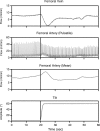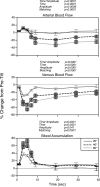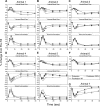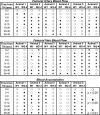Effects of postural changes and removal of vestibular inputs on blood flow to and from the hindlimb of conscious felines
- PMID: 19793952
- PMCID: PMC2803620
- DOI: 10.1152/ajpregu.00551.2009
Effects of postural changes and removal of vestibular inputs on blood flow to and from the hindlimb of conscious felines
Abstract
Considerable data show that the vestibular system contributes to blood pressure regulation. Prior studies reported that lesions that eliminate inputs from the inner ears attenuate the vasoconstriction that ordinarily occurs in the hindlimbs of conscious cats during head-up rotations. These data led to the hypothesis that labyrinthine-deficient animals would experience considerable lower body blood pooling during head-up postural alterations. The present study tested this hypothesis by comparing blood flow though the femoral artery and vein of conscious cats during 20-60 degrees head-up tilts from the prone position before and after removal of vestibular inputs. In vestibular-intact animals, venous return from the hindlimb dropped considerably at the onset of head-up tilts and, at 5 s after the initiation of 60 degrees rotations, was 66% lower than when the animals were prone. However, after the animals were maintained in the head-up position for another 15 s, venous return was just 33% lower than before the tilt commenced. At the same time point, arterial inflow to the limb had decreased 32% from baseline, such that the decrease in blood flow out of the limb due to the force of gravity was precisely matched by a reduction in blood reaching the limb. After vestibular lesions, the decline in femoral artery blood flow that ordinarily occurs during head-up tilts was attenuated, such that more blood flowed into the leg. Contrary to expectations, in most animals, venous return was facilitated, such that no more blood accumulated in the hindlimb than when labyrinthine signals were present. These data show that peripheral blood pooling is unlikely to account for the fluctuations in blood pressure that can occur during postural changes of animals lacking inputs from the inner ear. Instead, alterations in total peripheral resistance following vestibular dysfunction could affect the regulation of blood pressure.
Figures





Similar articles
-
Vestibular inputs elicit patterned changes in limb blood flow in conscious cats.J Physiol. 2006 Sep 1;575(Pt 2):671-84. doi: 10.1113/jphysiol.2006.112904. Epub 2006 Jun 29. J Physiol. 2006. PMID: 16809368 Free PMC article.
-
Effects of postural changes and removal of vestibular inputs on blood flow to the head of conscious felines.J Appl Physiol (1985). 2006 May;100(5):1475-82. doi: 10.1152/japplphysiol.01585.2005. Epub 2006 Jan 26. J Appl Physiol (1985). 2006. PMID: 16439511
-
Consequences of postural changes and removal of vestibular inputs on the movement of air in and out of the lungs of conscious felines.J Appl Physiol (1985). 2007 Jul;103(1):347-52. doi: 10.1152/japplphysiol.00211.2007. Epub 2007 Apr 12. J Appl Physiol (1985). 2007. PMID: 17431091
-
Integration of nonlabyrinthine inputs by the vestibular system: role in compensation following bilateral damage to the inner ear.J Vestib Res. 2009;19(5-6):183-9. doi: 10.3233/VES-2009-0337. J Vestib Res. 2009. PMID: 20495235 Free PMC article. Review.
-
Patterning of sympathetic nerve activity in response to vestibular stimulation.Brain Res Bull. 2000 Sep 1;53(1):11-6. doi: 10.1016/s0361-9230(00)00303-8. Brain Res Bull. 2000. PMID: 11033203 Review.
Cited by
-
Glutamate and GABA in Vestibulo-Sympathetic Pathway Neurons.Front Neuroanat. 2016 Feb 8;10:7. doi: 10.3389/fnana.2016.00007. eCollection 2016. Front Neuroanat. 2016. PMID: 26903817 Free PMC article.
-
Responses of neurons in the rostral ventrolateral medulla of conscious cats to anticipated and passive movements.Am J Physiol Regul Integr Comp Physiol. 2020 Mar 1;318(3):R481-R492. doi: 10.1152/ajpregu.00205.2019. Epub 2020 Jan 15. Am J Physiol Regul Integr Comp Physiol. 2020. PMID: 31940234 Free PMC article.
-
Vestibular Modulation of Sympathetic Nerve Activity to Muscle and Skin in Humans.Front Neurol. 2017 Jul 26;8:334. doi: 10.3389/fneur.2017.00334. eCollection 2017. Front Neurol. 2017. PMID: 28798718 Free PMC article. Review.
-
Sinusoidal galvanic vestibular stimulation (sGVS) induces a vasovagal response in the rat.Exp Brain Res. 2011 Apr;210(1):45-55. doi: 10.1007/s00221-011-2604-4. Epub 2011 Mar 4. Exp Brain Res. 2011. PMID: 21374078 Free PMC article.
-
Integrative responses of neurons in nucleus tractus solitarius to visceral afferent stimulation and vestibular stimulation in vertical planes.Am J Physiol Regul Integr Comp Physiol. 2011 Nov;301(5):R1380-90. doi: 10.1152/ajpregu.00361.2011. Epub 2011 Aug 10. Am J Physiol Regul Integr Comp Physiol. 2011. PMID: 21832211 Free PMC article.
References
-
- Carter JR, Ray CA. Sympathetic responses to vestibular activation in humans. Am J Physiol Regul Integr Comp Physiol 294: R681– R688, 2008 - PubMed
-
- Cotter LA, Arendt HE, Cass SP, Jian BJ, Mays DF, 2nd, Olsheski CJ, Wilkinson KA, Yates BJ. Effects of postural changes and vestibular lesions on genioglossal muscle activity in conscious cats. J Appl Physiol 96: 923– 930, 2004 - PubMed
-
- Cotter LA, Arendt HE, Jasko JG, Sprando C, Cass SP, Yates BJ. Effects of postural changes and vestibular lesions on diaphragm and rectus abdominis activity in awake cats. J Appl Physiol 91: 137– 144, 2001 - PubMed
-
- Cui J, Iwase S, Mano T, Katayama N, Mori S. Muscle sympathetic outflow during horizontal linear acceleration in humans. Am J Physiol Regul Integr Comp Physiol 281: R625– R634, 2001 - PubMed
-
- Davenport PW, Thompson FJ. Mechanosensitive afferents of femoral-saphenous vein. Am J Physiol Regul Integr Comp Physiol 252: R367– R370, 1987 - PubMed
Publication types
MeSH terms
Grants and funding
LinkOut - more resources
Full Text Sources
Medical
Miscellaneous

